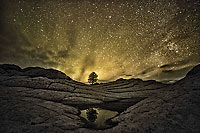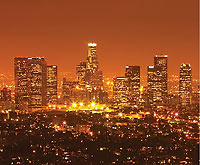Harun Mehmedinović kicked off this year’s Moab Festival of Science with a screening of stellar time-lapse footage from Skyglow Project, a joint project with Gavin Heffernan. Their time-lapse photography and videography are captivating the world in episodes of BBC Earth, National Geographic, Discovery Channel, and many more.
The night began with images of the natural cycles of day and night including natural nocturnal light sources such as the waxing and waning of the moon, light from hot lava, thunderstorms, and aurora borealis. Harun then highlighted the first light used by humans regularly, street-side oil lamps with its gentle orange glow. “In the past, humans readily observed the darkest of night skies. Then the collective light of billions of stars in our Milky Way was so intense it would cast shadows on new moon nights,” stated Harun.
With the electrification of the world, we moved into a new era of productivity and movement through the darkness of night. We did not realize the effect we would have on the ecosystems we rely so heavily on for food and resource production.
Skyglow Project’s images highlight the growing impact of artificial light at night on humans and the ecosystems we inhabit. “Light pollution impacts the health of humans and animals, especially nocturnal wildlife, and disrupts ecosystems. It also leads to waste of large percentages of energy and the disruption of astronomical research, among a long list of impacts. Light pollution runs counter to the necessity for a green, sustainable future.” Harun stated. He continued with, “Of all the pollution we face, light pollution is perhaps the most easily remedied. Simple changes in lighting design and installation yield immediate changes in the amount of light spilled into the atmosphere and, often, immediate energy savings.”
I’m confident we can solve the impacts we are facing from artificial light at night while still have the light we need within our cities. Effective lighting techniques place the light on the ground where we need it. It reduces glare for drivers and pedestrians increasing traffic safety, and prevent wasted energy, often sources from non-renewable fuels.
For more information on the Skyglow Project, visit skyglowproject.com
Moon Happenings
Oct 5 - First Quarter at 10:48 pm
Oct 13 - Full Moon at 3:07 pm


